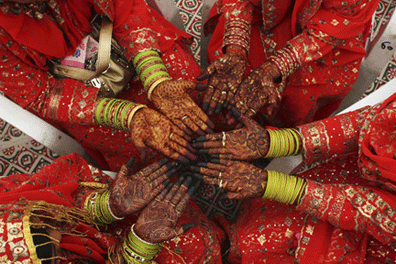
[Webshaykh’s Note: Revisionism is found in all religions. I recently came across a blog posting that seeks to restore the marital status of Muhammad to one wife at a time, although it appears to be more an attack on at-Tabari, Ibn Ishaq and Ibn Hisham. I post the commentary not because I agree with it, but as an example of the variety of views held by Muslims in representing the Prophet Muhammad.]
THE PROPHET (S) HAD ONLY ONE WIFE AT A TIME by Dr. Shabbir Ahmed, The Quran as it Explains Itself, August 30th, 2009
THE PROPHET (S) HAD ONLY ONE WIFE AT A TIME
MARRIAGE WITH HAZRAT AYESHA 622 CE:
Contrary to the Imamist propaganda, the exalted Prophet had no more than one wife at a time. And Hazrat Ayesha was a sister, not daughter of Hazrat Abu Bakr. The Prophet (S) did not marry for three years after Hazrat Khadijah’s demise in Makkah three years before Hijrah. Hazrat Ayesha was the widow of a martyr, Saleh bin Saleh Al-’Ataib. She was 48 years old at the time of marriage to the exalted Prophet. Sahaba Kiraam including Hazrat Abu Bakr strongly recommended that the Prophet (S) and she got into the solemn union of marriage. The blessed wedding took place in 622 CE when Muhammad (S) was 52 years old. Kitab-e-Dalail-e-Nabawwut Syedna Muhammad (S), by Abdul Jabbar Fatimi, written 150 years before Tabari, the first ever ‘canonized’ historian. Azwaaj-in-Nabi wal-Ashaab, by Sheikh Hammad bin Hakam. The rest is nothing but slanderous imagination of the Zoroastrian “Imam†Tabari and the Jewish biographer Ibn Ishaq and his Parsi follower Ibn Hisham.
OTHER WIVES!
The exalted Prophet was now also Head of the State. Quite a few Muslims had been killed in battles and by persecution. There were women who accepted Islam while their husbands did not. The Qur’an does not allow a Muslim woman to remain wedded to a Non-Muslim. In these circumstances, there were many women and their children who needed shelter. The Prophet (S) and his companions accommodated them in their homes. To prevent slander, these widows and divorcees simply signed marriage contracts in their new households.
To emphasize the point again, the exalted Messenger married only Hazrat Khadija when he was 25, and she was 40. They lived an ideal married life for 25 years. Hazrat Khadija died in Makkah at 65. Three years after her death and soon after migration to Madinah in AH 1, Muhammad (S) married Hazrat Ayesha, a sister of Hazrat Abu Bakr. She was then 48.
During the blessed times, the Central Government run with Shura used to issue a deed of marriage to all women seeking asylum with Rasool (S) and Sahaba Kiraam in order to prevent slander. This is the reason why the Qur’an mentions the exalted Prophet’s wives in plural. Please reflect on the many shades of the meaning of Nikah. Also consider why NONE BUT Hazrat Khadijah bore any children to the exalted Prophet.
Maria, the bondwoman reportedly “gifted†to the exalted prophet by the Egyptian ruler, is nothing but a malicious fabrication. How could the exalted prophet accept bondwomen and slaves when the Qur’an was emancipating them? One might assume well and think, “Well, in order to grant them freedom.†But our brilliant historians insist that Maria always remained a concubine!
These concealed books are scarcely available in Arabic only under strict protection of the Muslim clergy, under custody of the autocratic Arab world. Their stray copies are found in the Istanbul Museum, the library of Madinah University, Tashqand (Tashkent) Muslim Library in the former Soviet Union, Jame’ah Al-Azhar of Cairo, Maktaba Adnan in Beirut and in some cases they have been personally inherited by the progeny of the ancient scholars. These books are so well-guarded that only a few scholars have been able to partially photograph these precious documents. They are closely guarded since they demolish our mythical, but ‘canonized’ histories such as by Tabari, Ibn Atheer, and Ibn Khaldun and the conjecture based Biographies (Seera-tun-Nabi) of the Prophet (S) by Ibn Ishaq? – and Ibn Hisham.
[Ibn Ishaq’s work was quickly lost and is now only known in the works named after Ibn Hisham and al-Tabari. But as recently as 2000 CE, the Mullahs have miraculously reproduced Ibn Ishaq’s book from the magician’s hat or from God knows where!]
I am extremely grateful to my respected readers who, at the risk of life and imprisonment, have been mailing me these photographed excerpts.
References:
1. *** Azwaaj-in-Nabi wal-Ashaab, by Sheikh Hammad bin Hakam
2. *** Meezan-il-Faris by Hujjatullah Abdul Qadir Ali Al-Moosvi pg 249-26
3. *** Takmilatil Lughatal ‘Ain ‘Urfa by Al-Ustaz Jalaluddin Al-Ash’ari on Imam Al-Khalil ibn Ahmad Shikoh Tabrezi vol 2 pg 3-5
4. *** Kitab-e-Dalail-e-Nabawwut Syedna Muhammad (S), by Abdul Jabbar Fatimi, written 150 years before Tabari, the first ever ‘canonized’ historian
5.*** Darul Afaq Publishing Company of Beirut
6. *** Haroon Wa Baramikatil Faras by Sheikhul Ifta Salman bin Abu Qasim Baghdadi. Vol 1 pg 31-55
7. *** Mujahid-al-Munafiq Imam Ahmad bin Hanbal by Abdul Muhsin bin Mullah Ali Al-Qari, pg 67-135
8. *** Nufus-ul-Qudsiyah by Abdul Muhsin bin Mullah Ali Al-Qari